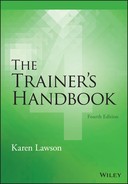References
- Allen, M. (2003). Guide to e-learning: Building interactive, fun, and effective learning programs for any company. Hoboken, NJ: Wiley.
- American Council on Education. (1996). Guiding principles for distance education in a learning society. Washington, DC: American Council on Education.
- Blanchard, K., & Miller, M. (2004). The secret. San Francisco, CA: Barrett-Koehler.
- Blanchard, K., & Muchnick. (2003). The leadership pill. New York, NY: Free Press.
- Cripple, G. (1996). Instructional styles diagnosis inventory. The 1996 Annual: Vol. 2, consulting (pp. 147–160). San Francisco, CA: Pfeiffer.
- El-Shamy, S. (2004). How to design and deliver training for the new and emerging generations. San Francisco, CA: Pfeiffer.
- Hacker, D. G. (1998). Testing for learning outcomes. Infoline. Alexandria, VA: American Society for Training and Development.
- Hall, E. T. (1966). The hidden dimension. Garden City, NY: Doubleday.
- Hofstede, G. (1980). Culture's consequences: International differences in work-related values. Beverly Hills, CA: Sage.
- Hofmann, J. (August 2011). Blended learning. Infoline. Alexandria, VA: American Society for Training & Development.
- Horton, W. (2000). Designing web-based training. Hoboken, NJ: Wiley.
- Jacobs, R.T. & Fuhrmann, B.S. (1984). Learning-style inventory. The 1984 annual: Developing human resources (pp. 106–111). San Diego: University Associates.
- James, W. B., & Galbraith, M. W. (1985, January). Perceptual learning styles: Implications and techniques for the practitioner. Lifelong Learning, 20–23.
- Johnson, D. W., Johnson, R. I., & Smith, K. A. (1991). Cooperative learning: Increasing college faculty instructional productivity. ASHE-ERIC Higher Education Report No. 4. Washington, DC: George Washington University, School of Education and Human Development.
- Keller, J. M. (1983). Motivational design of instruction. In C. M. Reigeluth (Ed.), Instructional-design theories and models: An overview of their current status. Hillsdale, NJ: Erlbaum.
- Kirk, J. (1995). Trainers' use of games: Some preliminary explorations (Unpublished manuscript). Cullobee, NC: Author.
- Kirkpatrick, D. (1994). Evaluating training programs: The four levels. San Francisco, CA: Berrett-Koehler.
- Knowles, M. (1990). The adult learner: A neglected species (4th ed.). Houston, TX: Gulf.
- Kolb, D. (1991). Learning style inventory. Boston, MA: McBer & Company.
- Lencioni, P. (1998). The five temptations of a CEO. San Francisco, CA: Jossey-Bass.
- Lencioni, P. (2000). The four obsessions of an extraordinary executive. San Francisco, CA: Jossey-Bass.
- Lencioni, P. (2002). The five dysfunctions of a team. San Francisco, CA: Jossey-Bass.
- Lencioni, P. (2007a). Death by meeting. San Francisco, CA: Jossey-Bass.
- Lencioni, P. (2007b). The three signs of a miserable job. San Francisco, CA: Jossey-Bass.
- Livo, N. J., & Rietz, S. A. (1986). Storytelling process & practice. Santa Barbara, CA: Libraries Unlimited.
- Lundin, S. C., Paul, H., & Christensen, J. (2000). Fish: A remarkable way to boost morale and improve results. New York, NY: Hyperion.
- Mayer, R. E. (2001). Multimedia learning. Cambridge, UK: Cambridge University Press.
- McNeish, R. (1972). Lessons from the geese. (Unpublished sermon). Reistertown, MD: Author.
- Meyers, E., & Jones, T. B. (1993). Promoting active learning: Strategies for the college classroom. San Francisco, CA: Jossey-Bass.
- Miller, G. A. (1956). The magical number seven, plus or minus two: Some limits on our capacity for processing information. Psychological Review, 83, 81–97.
- Morrison, T., & Conaway, W. A. (2006). Kiss, bow, or shake hands (2nd ed.). Avon, MA: Adams Media.
- Multicultural Calendar. Toronto, ON: Creative Cultural Communications.
- Murrell, K.L. (1987). The learning-model instrument: An instrument based on the learning model for managers. The 1997 annual: Developing human resources (pp. 109–119). San Diego: University Associates.
- Oppenheim, L. (1981). Studies of the effects of the use of overhead transparencies on business meetings. Philadelphia: Wharton Applied Research Center, Wharton School, University of Pennsylvania.
- Parkin, M. (1998). Tales for trainers: Using stories and metaphors to facilitate learning. London, UK: Kogan-Page.
- Peoples, D.A. (1992). Presentations plus: David Peoples' proven techniques (Rev. ed.). New York, NY: Wiley.
- Pescuric, A., & Byham, W.C. (1996, July). The new look of behavior modeling. Training & Development, pp. 24–30.
- Phillips, K.R. (2004). Coaching skills inventory (3rd ed.). King of Prussia, PA: HRDQ.
- Scannell, E.E., & Newstrom, J.W. (1983). More games trainers play. New York, NY: McGraw-Hill.
- Silberman, M. (2005). 101 ways to make training active (2nd ed.). San Francisco: Pfeiffer.
- Silberman, M. (2006). Active training (3rd ed.). San Francisco, CA: Pfeiffer.
- Silberman, M., & Lawson, K. (1995). 101 ways to make training active. San Francisco, CA: Pfeiffer.
- Sterns, H., & Doverspike, D. (1988). Training and developing the older worker: Implications for human resource management. In H. Dennis (Ed.), Fourteen steps in managing an aging work force. Lexington, MA: Lexington Books.
- Sugar, S. (1998). Games that teach. San Francisco, CA: Pfeiffer.
- Thomas, D.C., & Inkson, K. (2003). Cultural intelligence: People skills for global business. San Francisco, CA: Berrett-Koehler.
- Thomas, K., & Kilmann, R. (1974). The Thomas-Kilman conflict mode instrument. Sterling Forest, NY: Xicom.
- Vogel, D.R., Dickson, G.W., & Lehman, J.A. (1986). Persuasion and the role of visual presentation support: The UM/3M study. Minneapolis: Management Information Systems Research Center, School of Management, University of Minnesota.
- Walters, L. (1993). Secrets of successful speakers. New York, NY: McGraw-Hill.
- White, K. (1996, September). Ten most frequently asked questions and their answers. Training & Development, 26–30.
- Zemke, R., & Armstrong, J. (1997, May). How long does it take? Training, 69–79.
- Zemke, R., Raines, C., & Filipczak, B. (1999, November). Generation gaps in the classroom. Training, 48–54.
..................Content has been hidden....................
You can't read the all page of ebook, please click here login for view all page.
